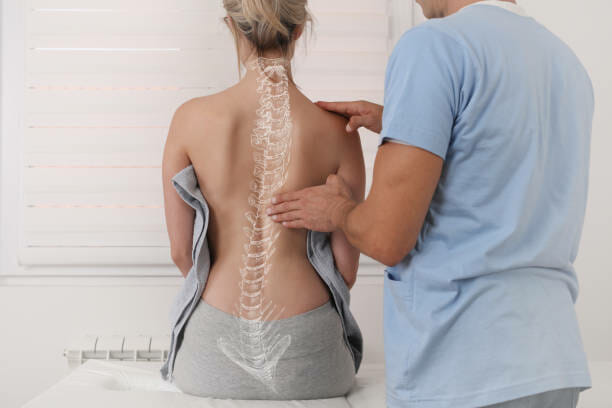Scoliosis affects the curvature of the spine, causing it to deviate from its normal alignment. From its causes and symptoms to available treatment options, we will delve into every aspect of this condition, shedding light on its impact on individuals’ lives. This article aims to increase awareness and understanding of scoliosis to empower those affected and their loved ones with the knowledge necessary for effective management.
Identifying the Early Signs of Scoliosis
Identifying the early signs of scoliosis is crucial for early intervention and effective treatment. The first noticeable sign is usually an abnormal spine curvature, which may appear as an S or a C shape. A visible asymmetry in the shoulders, waistline, or hips is another early indicator. Common symptoms include back pain, fatigue, and uneven shoulder or hip height. However, it’s important to note that scoliosis can vary in severity and may not always present with noticeable symptoms. Regular screenings during adolescence, when scoliosis commonly develops, can help detect the condition early.
Early identification of scoliosis is key in preventing further progression and complications. If left untreated, scoliosis can lead to pain, discomfort, and decreased lung capacity. A professional healthcare provider, such as a paediatrician, orthopaedic specialist, or chiropractor, may perform a thorough physical examination to assess a patient’s spinal curvature and identify any other potential signs of scoliosis. X-rays and other imaging tests may also be used to diagnose more accurately. With timely intervention, individuals with scoliosis can access appropriate treatment options, such as physical therapy, bracing, or, in severe cases, surgery. By recognising the early signs of scoliosis, individuals and their loved ones can take proactive steps towards managing and treating this condition effectively.
Navigating Treatment Options
The treatment options for scoliosis depend on several factors, including the severity of the spinal curvature, the age of the patient, and the underlying cause of scoliosis. Here are the primary treatment options for scoliosis:
1. Observation and Monitoring: Observation and regular monitoring may be recommended for mild cases of scoliosis (with a curve less than 25 degrees), especially in adolescents who are still growing. The healthcare provider will track the progression of the curvature through periodic X-rays to determine if any treatment is needed.
2. Bracing: Bracing is often prescribed for moderate scoliosis (with a curve between 25 and 40 degrees) in adolescents who are still growing. The brace helps slow or stop the curve’s progression by applying corrective pressure to the spine. The brace type and wear duration will depend on the specific case.
3. Physical Therapy and Exercise: Physical therapy and targeted exercises can improve posture, spinal strength, and flexibility. While they may not correct the curvature, they can help manage symptoms and improve overall spinal health.
4. Pain Management: Over-the-counter pain relievers or prescription medications may be recommended for scoliosis-related pain. Physical therapy and other pain management techniques can also help alleviate discomfort.
5. Custom Orthotics: In some cases, custom-made shoe inserts (orthotics) or back braces may help improve posture and reduce pain, especially in individuals with scoliosis-related leg length discrepancies.
6. Scoliosis-Specific Exercises (Schroth Method): Some physical therapists specialise in scoliosis-specific exercises like the Schroth method. These exercises are tailored to the individual’s curve pattern and aim to improve posture and reduce pain.
7. Casting (Mehta Casting): Casting may guide spinal growth and prevent curve progression in very young children with infantile or juvenile scoliosis. The casting is periodically adjusted as the child grows.
8. Surgery: Surgery is considered for severe scoliosis (with a curve more significant than 40 degrees) that continues progressing despite non-surgical treatments or where the spinal curvature threatens organ function or overall health. The most common surgical procedure for scoliosis is spinal fusion, which involves straightening the spine and fusing the affected vertebrae with rods, screws, and bone grafts. Surgery aims to prevent further curvature progression and improve spinal alignment.
Treatment choice depends on several factors, including the degree of curvature, age, overall health, and individual preferences. Treatment decisions are typically made in consultation with an orthopaedic specialist or a scoliosis specialist who can evaluate the case and recommend the most appropriate course of action. Early detection and intervention are essential for the most successful outcomes in scoliosis treatment.
Connecting with a Supportive Community
Connecting with a supportive community is a crucial aspect of managing scoliosis. Dealing with a condition like scoliosis can often feel isolating, but finding a community of individuals facing similar challenges can provide much-needed support and reassurance. Whether through online forums, support groups, or local meetups, connecting with others who understand scoliosis’s physical and emotional impact can make a significant difference in one’s journey.
In a supportive community, individuals can share their experiences, ask questions, and find solace in knowing they are not alone. This sense of camaraderie can provide emotional support and help individuals navigate the challenges of living with scoliosis. Additionally, being part of a community allows access to a wealth of knowledge, as members often share tips for managing pain, treatment options, and recommendations for healthcare providers specialising in scoliosis.
A supportive community can empower individuals by providing a platform to advocate for scoliosis awareness and education. Community members can join forces to raise awareness about the condition, debunk common misconceptions, and promote early detection and comprehensive treatment. Together, they can become a united voice, working towards a society that understands and supports those with scoliosis.
